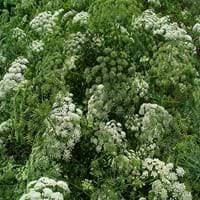Life Span
Perennial
Annual and Perennial
Origin
Southern Europe
Southern Europe, Mediterranean, Northern Africa
Types
Bigleaf hydrangea, Hortensia, Smooth hydrangea, Oakleaf hydrangea, Annabelle
Not Available
Number of Varieties
Not Available
Habitat
Forest edges, Hillside, Woods
Cultivated Beds, Loamy soils, Sandy areas, Well Drained
USDA Hardiness Zone
5-9
8-15
Sunset Zone
21,22
A1, A2, A3, H1, H2, 1a, 1b, 2a, 2b, 3a, 3b, 4, 5, 6, 7, 8, 9, 10, 11, 12, 13, 14, 15, 16, 17, 18, 19, 20, 21, 22, 23, 24
Habit
Clump-Forming
Upright/Erect
Flower Color
Yellow green
White
Flower Color Modifier
Bicolor
Bicolor
Fruit Color
Sandy Brown
Sandy Brown
Leaf Color in Spring
Green
Green, Light Green
Leaf Color in Summer
Green
Green, Light Green
Leaf Color in Fall
Green
Green, Light Green
Leaf Color in Winter
Light Green
Light Green
Leaf Shape
Oblovate
Small oblong
Plant Season
Spring, Summer, Fall
Spring, Summer, Fall
Sunlight
Full Sun, Partial Sun, Partial shade
Full Sun, Partial Sun
Growth Rate
Fast
Very Fast
Type of Soil
Loam, Sand
Loam, Sand
The pH of Soil
Neutral
Neutral
Soil Drainage
Well drained
Well drained
Bloom Time
Early Summer, Summer, Late Summer
Early Summer, Summer, Late Summer, Early Fall, Indeterminate
Tolerances
Drought
Drought
Where to Plant?
Container, Ground
Ground
How to Plant?
Seedlings, Stem Planting
Rooted stem cutting, Seedlings
Plant Maintenance
Medium
Medium
Watering Requirements
Not Available
Do Not over Water, Water daily during growing season, Water Deeply, Water in morning to avoid prompting diseases
In Summer
Average Water
Lots of watering
In Spring
Moderate
Moderate
In Winter
Average Water
Average Water
Soil pH
Neutral
Acidic, Alkaline, Neutral
Soil Type
Loam, Sand
Loam, Sand, Well drained
Soil Drainage Capacity
Well drained
Rich
Sun Exposure
Full Sun, Partial Sun, Partial shade
Full Sun, Partial shade
Pruning
Remove damaged leaves, Remove dead branches, Remove dead leaves
Prune after flowering
Fertilizers
All-Purpose Liquid Fertilizer
All-Purpose Liquid Fertilizer, fertilize in growing season, Nitrogen, Phosphorous, Potassium
Pests and Diseases
Red blotch
Red blotch
Plant Tolerance
Drought
Drought
Flowers
Insignificant
Yes
Flower Petal Number
Single
Single
Fragrant Leaf
Yes
Not Available
Fragrant Bark/Stem
Yes
Not Available
Foliage Texture
Medium
Fine
Foliage Sheen
Glossy
Matte
Evergreen
Semi-Evergreen
No
Attracts
Butterflies
Butterflies
Allergy
Chest tightness, Diarrhea, Dizziness, Nausea, Vomiting
Headache, Hyperacidity, Liver disease, Nausea, Skin irritation, Vomiting
Aesthetic Uses
Not Available
Showy Purposes
Beauty Benefits
Not Available
Not Available
Edible Uses
Not Available
Yes
Environmental Uses
Air purification
Air purification, Weather protection
Medicinal Uses
Fever, Kidney problems, Urinary tract problems
Asthma, Digestive disorders, Psoriasis, Reduces toothache, Vitiligo
Part of Plant Used
Flowers, Root
Root, Seeds
Other Uses
Not Available
Edible syrup, Used As Food, Used for its medicinal properties
Used As Indoor Plant
Not Available
No
Used As Outdoor Plant
Yes
Yes
Garden Design
Edible, Herb / Vegetable
Groundcover, Lawns and Turf, Mixed Border
Botanical Name
PETROSELINUM crispum var. tuberosum
AMMI majus
Common Name
Hamburg Parsley
Bishop's Weed, Bullwort
In Hindi
Hydrangea
बिशप निराना
In German
Hortensie
Bischofs Unkraut
In French
Hortensia
la mauvaise herbe de l'évêque
In Spanish
Hortensia
biznaga
In Greek
υδραγεία
ζιζανίων επισκόπου
In Portuguese
Hortênsia
erva daninha do Bispo
In Polish
Hortensja
chwastów biskupa
In Latin
Hibiscus
Episcopi viriditas
Phylum
Not Available
Magnoliophyta
Class
Not Available
Magnoliopsida
Order
Not Available
Apiales
Genus
Not Available
Trachyspermum
Clade
Not Available
Angiosperms, Asterids, Eudicots
Tribe
Not Available
Not Available
Subfamily
Not Available
Not Available
Number of Species
Not Available
Not Available
Properties of Hamburg Parsley and Bishop's Weed
Wondering what are the properties of Hamburg Parsley and Bishop's Weed? We provide you with everything About Hamburg Parsley and Bishop's Weed. Hamburg Parsley doesn't have thorns and Bishop's Weed doesn't have thorns. Also Hamburg Parsley does not have fragrant flowers. Hamburg Parsley has allergic reactions like Chest tightness, Diarrhea, Dizziness, Nausea and Vomiting and Bishop's Weed has allergic reactions like Chest tightness, Diarrhea, Dizziness, Nausea and Vomiting. Compare all the properties and characteristics of these two plants. Find out which of these plant can be used as indoor plant. If you are interested to decorate your house and garden, find out aesthetic uses, compare them and select the plant which will beautify your surrounding. Along with beautification, try comparing medicinal and edible uses of Hamburg Parsley and Bishop's Weed and you can choose the plant having best and most benefits.
Season and Care of Hamburg Parsley and Bishop's Weed
Season and care of Hamburg Parsley and Bishop's Weed is important to know. While considering everything about Hamburg Parsley and Bishop's Weed Care, growing season is an essential factor. Hamburg Parsley season is Spring, Summer and Fall and Bishop's Weed season is Spring, Summer and Fall. The type of soil for Hamburg Parsley is Loam, Sand and for Bishop's Weed is Loam, Sand while the PH of soil for Hamburg Parsley is Neutral and for Bishop's Weed is Neutral.
Hamburg Parsley and Bishop's Weed Physical Information
Hamburg Parsley and Bishop's Weed physical information is very important for comparison. Hamburg Parsley height is 30.50 cm and width 30.50 cm whereas Bishop's Weed height is 90.00 cm and width 30.00 cm. The color specification of Hamburg Parsley and Bishop's Weed are as follows:
Hamburg Parsley flower color: Yellow green
Hamburg Parsley leaf color: Green
Bishop's Weed flower color: White
- Bishop's Weed leaf color: Green and Light Green
Care of Hamburg Parsley and Bishop's Weed
Care of Hamburg Parsley and Bishop's Weed include pruning, fertilizers, watering etc. Hamburg Parsley pruning is done Remove damaged leaves, Remove dead branches and Remove dead leaves and Bishop's Weed pruning is done Prune after flowering. In summer Hamburg Parsley needs Average Water and in winter, it needs Average Water. Whereas, in summer Bishop's Weed needs Lots of watering and in winter, it needs Average Water.

